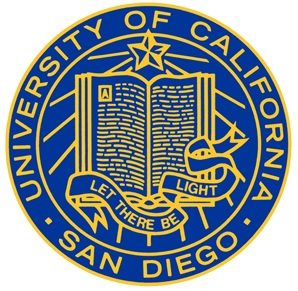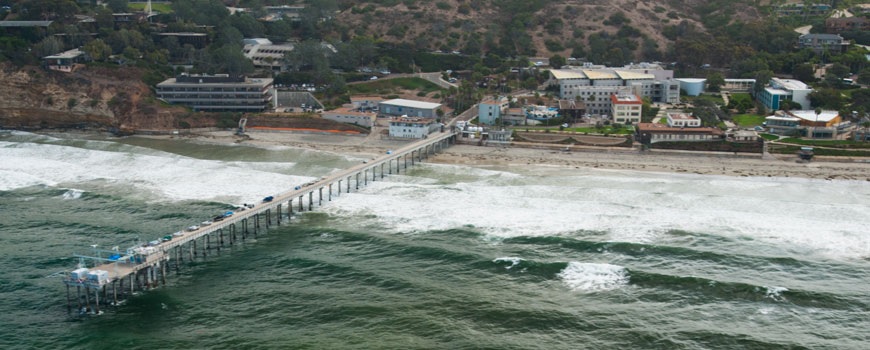From The University of California-San Diego
and
Scripps Institution of Oceanography
Liezel Labios
858-246-1124
llabios@ucsd.edu
Robert Monroe
858-534-3624
scrippsnews@ucsd.edu
Images by Daniel Wangpraseurt.
A team of researchers involving the University of California San Diego has received a $25 million award from the U.S. Department of Defense’s Defense Advanced Research Projects Agency (DARPA) to build artificial coral reefs to protect coastal areas in Hawai’i against flooding, erosion and storm damage.
The artificial reefs will be designed to work with local ecology to create a living, growing and self-healing system. The reefs will provide a natural defense that can keep pace with sea-level rise over time and slow down waves, dissipating their energy before they reach land. A big benefit of artificial reefs is that they can be rapidly deployed to provide immediate protection while promoting the growth of reef-supporting organisms. Natural reefs take decades to mature, but the artificial versions can reach full functionality in a matter of months to years.
The project is an academic-industry partnership led by the University of Hawai’i, with other partners including UC San Diego, Florida Atlantic University and Makai Ocean Engineering.
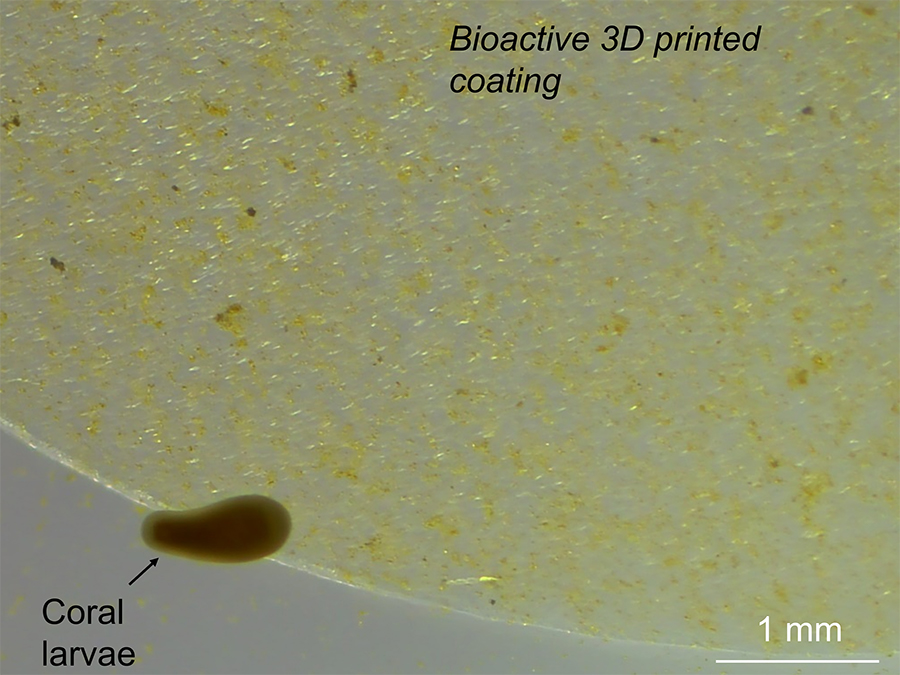
Coral larvae crawling over a bioactive coating to look for a settlement habitat. Such a bioactive material can be rapidly fabricated via 3D printing.
The UC San Diego team is working on two methods for attracting both corals and beneficial reef fish to the artificial structures. First, researchers at the UC San Diego Department of NanoEngineering will 3D print biomaterials that will be coated onto the artificial reefs. The biomaterials will be designed with special microstructures to enhance coral recruitment, the process in which tiny drifting coral larvae attach and establish themselves on a reef. The microstructures also aim to inhibit algal and bacterial fouling on the artificial reefs.
Scientists at UC San Diego’s Scripps Institution of Oceanography will also test “acoustic enrichment,” a process where sounds from other healthy reef environments are broadcast to attract both algae-eating fish and coral larvae to the structures. Scripps Oceanography scientists will also conduct passive acoustic monitoring of the reef structure to help monitor what and how many organisms settle on the structure over time.
Daniel Wangpraseurt, an assistant project scientist at the UC San Diego Jacobs School of Engineering, will lead the effort with co-investigators Shaochen Chen, professor and chair of nanoengineering at the UC San Diego Jacobs School of Engineering, and Aaron Thode, a research scientist at Scripps Oceanography. The UC San Diego effort will be funded with $4 million of the DARPA award.
“This is an exciting opportunity for radical innovation, with the potential to be a game changer for the engineering of artificial coral reefs,” said Wangpraseurt. “Our team will develop new biomaterials that will kick-start the living reef by applying state-of-the-art medical tissue engineering approaches.”
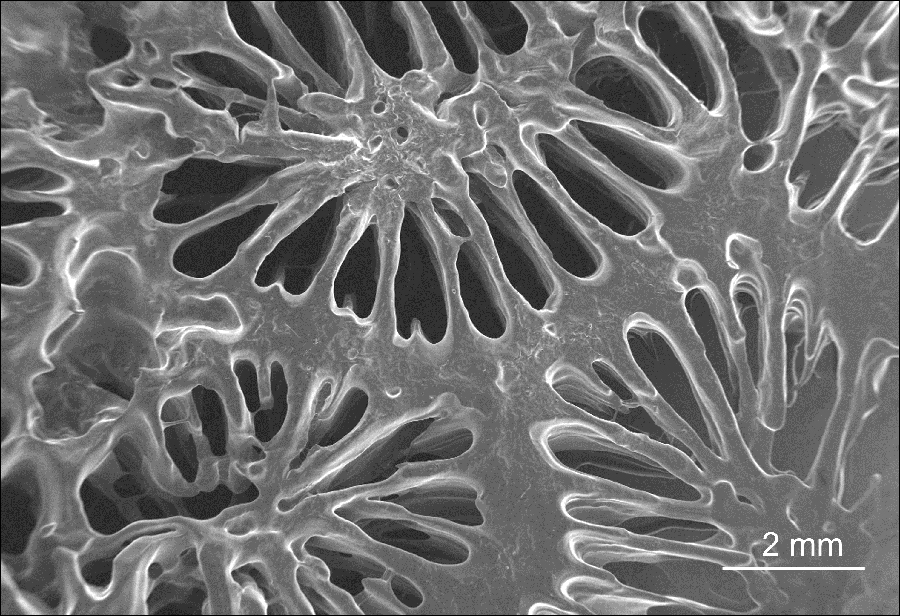
3D printed skeletal microarchitecture that can be used as inspiration for new reef-like materials.
To create the biomaterials, the UC San Diego team will use a rapid, 3D bioprinting technology developed in Chen’s lab. The technology can reproduce detailed microscale structures in mere seconds, mimicking the complex designs and functions of living tissues. Wangpraseurt and Chen have collaborated in recent years to 3D print coral-inspired microscale structures that are capable of growing dense populations of microscopic algae. The new DARPA-funded project takes their work to the next level, expanding their efforts to help create hybrid biological and engineered reef-mimicking structures for coastal defenses suited to a changing environment.
“We are now scaling up our rapid bioprinting platform, which will be critical to manufacture biomaterials for large scale coral reef engineering,” said Chen.
Thode, who recently participated in another recent DARPA-funded project on coral reef acoustics, will be adapting underwater sound playback technology initially developed to attract sperm whales away from fishing vessels to prevent the 70-foot animals from taking fish from their haul.
“In addition to developing methods to encourage rapid ecosystem development on artificial reefs, I’m hoping in the future this research could also help accelerate efforts to recover degraded or dying natural reefs,” said Thode.
3D printed corals provide more fertile ground for algae growth
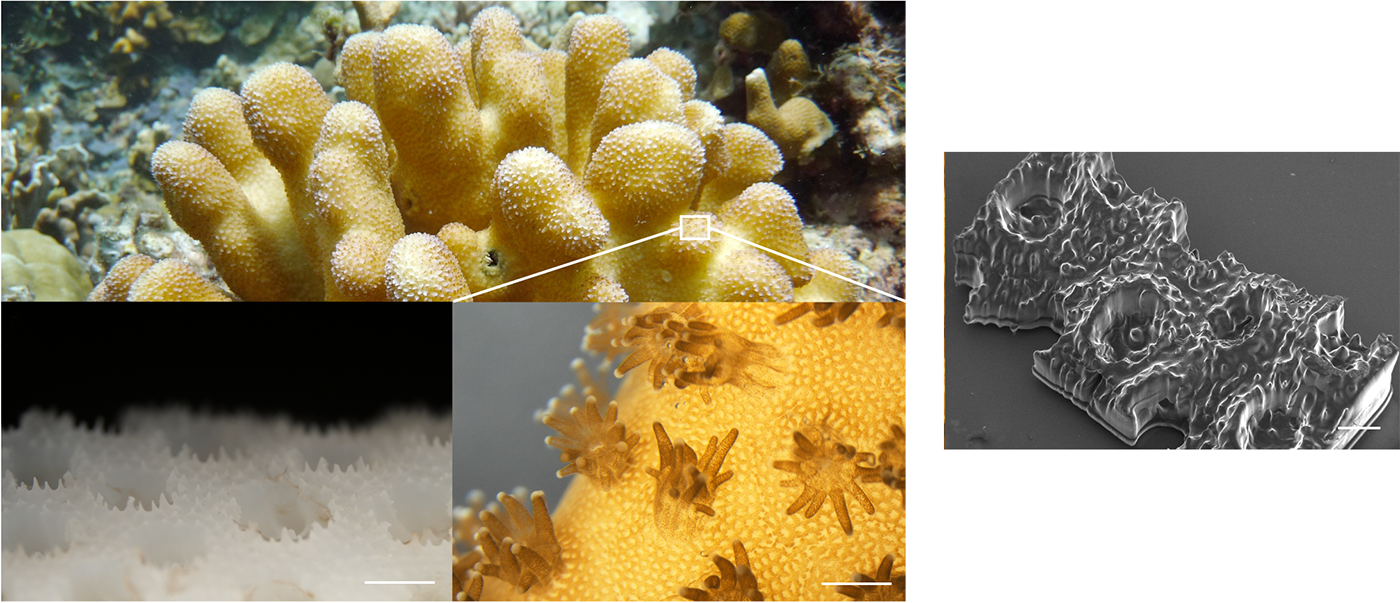
Left: Close-up of coral reef microstructures consisting of a coral skeleton (white) and coral tissue (orange-yellow). Right: SEM image of 3D printed coral skeleton. Images courtesy of Nature Communications.
See the full article here .
five-ways-keep-your-child-safe-school-shootings
Please help promote STEM in your local schools.
A department of UC San Diego, Scripps Institution of Oceanography is one of the oldest, largest, and most important centers for ocean, earth and atmospheric science research, education, and public service in the world.
Research at Scripps encompasses physical, chemical, biological, geological, and geophysical studies of the oceans, Earth, and planets. Scripps undergraduate and graduate programs provide transformative educational and research opportunities in ocean, earth, and atmospheric sciences, as well as degrees in climate science and policy and marine biodiversity and conservation.
The University of California- San Diego, is a public research university located in the La Jolla area of San Diego, California, in the United States. The university occupies 2,141 acres (866 ha) near the coast of the Pacific Ocean with the main campus resting on approximately 1,152 acres (466 ha). Established in 1960 near the pre-existing Scripps Institution of Oceanography, University of California-San Diego is the seventh oldest of the 10 University of California campuses and offers over 200 undergraduate and graduate degree programs, enrolling about 22,700 undergraduate and 6,300 graduate students. The University of California-San Diego is one of America’s “Public Ivy” universities, which recognizes top public research universities in the United States. The University of California-San Diego was ranked 8th among public universities and 37th among all universities in the United States, and rated the 18th Top World University by U.S. News & World Report’s 2015 rankings.
The University of California-San Diego is organized into seven undergraduate residential colleges (Revelle; John Muir; Thurgood Marshall; Earl Warren; Eleanor Roosevelt; Sixth; and Seventh), four academic divisions (Arts and Humanities; Biological Sciences; Physical Sciences; and Social Sciences), and seven graduate and professional schools (Jacobs School of Engineering; Rady School of Management; Scripps Institution of Oceanography; School of Global Policy and Strategy; School of Medicine; Skaggs School of Pharmacy and Pharmaceutical Sciences; and the newly established Wertheim School of Public Health and Human Longevity Science). University of California-San Diego Health, the region’s only academic health system, provides patient care; conducts medical research; and educates future health care professionals at the University of California-San Diego Medical Center, Hillcrest; Jacobs Medical Center; Moores Cancer Center; Sulpizio Cardiovascular Center; Shiley Eye Institute; Institute for Genomic Medicine; Koman Family Outpatient Pavilion and various express care and urgent care clinics throughout San Diego.
The university operates 19 organized research units (ORUs), including the Center for Energy Research; Qualcomm Institute (a branch of the California Institute for Telecommunications and Information Technology); San Diego Supercomputer Center; and the Kavli Institute for Brain and Mind, as well as eight School of Medicine research units, six research centers at Scripps Institution of Oceanography and two multi-campus initiatives, including the Institute on Global Conflict and Cooperation. The University of California-San Diego is also closely affiliated with several regional research centers, such as the Salk Institute; the Sanford Burnham Prebys Medical Discovery Institute; the Sanford Consortium for Regenerative Medicine; and the Scripps Research Institute. It is classified among “R1: Doctoral Universities – Very high research activity”. According to the National Science Foundation, UC San Diego spent $1.265 billion on research and development in fiscal year 2018, ranking it 7th in the nation.
The University of California-San Diego is considered one of the country’s “Public Ivies”. As of February 2021, The University of California-San Diego faculty, researchers and alumni have won 27 Nobel Prizes and three Fields Medals, eight National Medals of Science, eight MacArthur Fellowships, and three Pulitzer Prizes. Additionally, of the current faculty, 29 have been elected to the National Academy of Engineering, 70 to the National Academy of Sciences, 45 to the National Academy of Medicine and 110 to the American Academy of Arts and Sciences.
History
When the Regents of the University of California originally authorized the San Diego campus in 1956, it was planned to be a graduate and research institution, providing instruction in the sciences, mathematics, and engineering. Local citizens supported the idea, voting the same year to transfer to the university 59 acres (24 ha) of mesa land on the coast near the preexisting Scripps Institution of Oceanography. The Regents requested an additional gift of 550 acres (220 ha) of undeveloped mesa land northeast of Scripps, as well as 500 acres (200 ha) on the former site of Camp Matthews from the federal government, but Roger Revelle, then director of Scripps Institution and main advocate for establishing the new campus, jeopardized the site selection by exposing the La Jolla community’s exclusive real estate business practices, which were antagonistic to minority racial and religious groups. This outraged local conservatives, as well as Regent Edwin W. Pauley.
University of California President Clark Kerr satisfied San Diego city donors by changing the proposed name from University of California, La Jolla, to University of California-San Diego. The city voted in agreement to its part in 1958, and the University of California approved construction of the new campus in 1960. Because of the clash with Pauley, Revelle was not made chancellor. Herbert York, first director of DOE’s Lawrence Livermore National Laboratory, was designated instead. York planned the main campus according to the “Oxbridge” model, relying on many of Revelle’s ideas.
According to Kerr, “San Diego always asked for the best,” though this created much friction throughout the University of California system, including with Kerr himself, because University of California-San Diego often seemed to be “asking for too much and too fast.” Kerr attributed University of California-San Diego’s “special personality” to Scripps, which for over five decades had been the most isolated University of California unit in every sense: geographically, financially, and institutionally. It was a great shock to the Scripps community to learn that Scripps was now expected to become the nucleus of a new University of California campus and would now be the object of far more attention from both the university administration in Berkeley and the state government in Sacramento.
The University of California-San Diego was the first general campus of the University of California to be designed “from the top down” in terms of research emphasis. Local leaders disagreed on whether the new school should be a technical research institute or a more broadly based school that included undergraduates as well. John Jay Hopkins of General Dynamics Corporation pledged one million dollars for the former while the City Council offered free land for the latter. The original authorization for the University of California-San Diego campus given by the University of California Regents in 1956 approved a “graduate program in science and technology” that included undergraduate programs, a compromise that won both the support of General Dynamics and the city voters’ approval.
Nobel laureate Harold Urey, a physicist from the University of Chicago, and Hans Suess, who had published the first paper on the greenhouse effect with Revelle in the previous year, were early recruits to the faculty in 1958. Maria Goeppert-Mayer, later the second female Nobel laureate in physics, was appointed professor of physics in 1960. The graduate division of the school opened in 1960 with 20 faculty in residence, with instruction offered in the fields of physics, biology, chemistry, and earth science. Before the main campus completed construction, classes were held in the Scripps Institution of Oceanography.
By 1963, new facilities on the mesa had been finished for the School of Science and Engineering, and new buildings were under construction for Social Sciences and Humanities. Ten additional faculty in those disciplines were hired, and the whole site was designated the First College, later renamed after Roger Revelle, of the new campus. York resigned as chancellor that year and was replaced by John Semple Galbraith. The undergraduate program accepted its first class of 181 freshman at Revelle College in 1964. Second College was founded in 1964, on the land deeded by the federal government, and named after environmentalist John Muir two years later. The University of California-San Diego School of Medicine also accepted its first students in 1966.
Political theorist Herbert Marcuse joined the faculty in 1965. A champion of the New Left, he reportedly was the first protester to occupy the administration building in a demonstration organized by his student, political activist Angela Davis. The American Legion offered to buy out the remainder of Marcuse’s contract for $20,000; the Regents censured Chancellor William J. McGill for defending Marcuse on the basis of academic freedom, but further action was averted after local leaders expressed support for Marcuse. Further student unrest was felt at the university, as the United States increased its involvement in the Vietnam War during the mid-1960s, when a student raised a Viet Minh flag over the campus. Protests escalated as the war continued and were only exacerbated after the National Guard fired on student protesters at Kent State University in 1970. Over 200 students occupied Urey Hall, with one student setting himself on fire in protest of the war.
Early research activity and faculty quality, notably in the sciences, was integral to shaping the focus and culture of the university. Even before The University of California-San Diego had its own campus, faculty recruits had already made significant research breakthroughs, such as the Keeling Curve, a graph that plots rapidly increasing carbon dioxide levels in the atmosphere and was the first significant evidence for global climate change; the Kohn–Sham equations, used to investigate particular atoms and molecules in quantum chemistry; and the Miller–Urey experiment, which gave birth to the field of prebiotic chemistry.
Engineering, particularly computer science, became an important part of the university’s academics as it matured. University researchers helped develop University of California-San Diego Pascal, an early machine-independent programming language that later heavily influenced Java; the National Science Foundation Network, a precursor to the Internet; and the Network News Transfer Protocol during the late 1970s to 1980s. In economics, the methods for analyzing economic time series with time-varying volatility (ARCH), and with common trends (cointegration) were developed. The University of California-San Diego maintained its research intense character after its founding, racking up 25 Nobel Laureates affiliated within 50 years of history; a rate of five per decade.
Under Richard C. Atkinson’s leadership as chancellor from 1980 to 1995, the university strengthened its ties with the city of San Diego by encouraging technology transfer with developing companies, transforming San Diego into a world leader in technology-based industries. He oversaw a rapid expansion of the School of Engineering, later renamed after Qualcomm founder Irwin M. Jacobs, with the construction of the San Diego Supercomputer Center and establishment of the computer science, electrical engineering, and bioengineering departments. Private donations increased from $15 million to nearly $50 million annually, faculty expanded by nearly 50%, and enrollment doubled to about 18,000 students during his administration. By the end of his chancellorship, the quality of The University of California-San Diego graduate programs was ranked 10th in the nation by the National Research Council.
The university continued to undergo further expansion during the first decade of the new millennium with the establishment and construction of two new professional schools — the Skaggs School of Pharmacy and Rady School of Management—and the California Institute for Telecommunications and Information Technology, a research institute run jointly with University of California Irvine. The University of California-San Diego also reached two financial milestones during this time, becoming the first university in the western region to raise over $1 billion in its eight-year fundraising campaign in 2007 and also obtaining an additional $1 billion through research contracts and grants in a single fiscal year for the first time in 2010. Despite this, due to the California budget crisis, the university loaned $40 million against its own assets in 2009 to offset a significant reduction in state educational appropriations. The salary of Pradeep Khosla, who became chancellor in 2012, has been the subject of controversy amidst continued budget cuts and tuition increases.
On November 27, 2017, the university announced it would leave its longtime athletic home of the California Collegiate Athletic Association, an NCAA Division II league, to begin a transition to Division I in 2020. At that time, it will join the Big West Conference, already home to four other UC campuses (Davis, Irvine, Riverside, Santa Barbara). The transition period will run through the 2023–24 school year. The university prepares to transition to NCAA Division I competition on July 1, 2020.
Research
Applied Physics and Mathematics
The Nature Index lists The University of California-San Diego as 6th in the United States for research output by article count in 2019. In 2017, The University of California-San Diego spent $1.13 billion on research, the 7th highest expenditure among academic institutions in the U.S. The university operates several organized research units, including the Center for Astrophysics and Space Sciences (CASS), the Center for Drug Discovery Innovation, and the Institute for Neural Computation. The University of California-San Diego also maintains close ties to the nearby Scripps Research Institute and Salk Institute for Biological Studies. In 1977, The University of California-San Diego developed and released the University of California-San Diego Pascal programming language. The university was designated as one of the original national Alzheimer’s disease research centers in 1984 by the National Institute on Aging. In 2018, The University of California-San Diego received $10.5 million from the DOE National Nuclear Security Administration to establish the Center for Matters under Extreme Pressure (CMEC).
The university founded the San Diego Supercomputer Center (SDSC) in 1985, which provides high performance computing for research in various scientific disciplines. In 2000, The University of California-San Diego partnered with The University of California-Irvine to create the Qualcomm Institute – University of California-San Diego, which integrates research in photonics, nanotechnology, and wireless telecommunication to develop solutions to problems in energy, health, and the environment.
The University of California-San Diego also operates the Scripps Institution of Oceanography, one of the largest centers of research in earth science in the world, which predates the university itself. Together, SDSC and SIO, along with funding partner universities California Institute of Technology, San Diego State University, and The University of California-Santa Barbara, manage the High Performance Wireless Research and Education Network.
